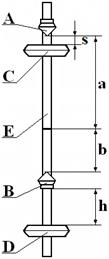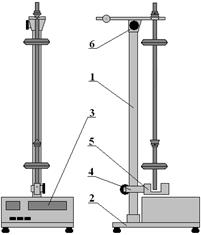Determination OF THE FREE FALL ACCELERATION WITH HELP OF REVERSIBLE PENDULUM
Purpose of work: to study the method of determination of acceleration
of the free falling by reversible pendulum.
Task: to measure the acceleration of the free falling - g.
Devices and equipment: reversible pendulum, electronic stopwatch.
Experimental installation description
 |
 Experimental installation is represented in figure 1. On a vertical column 1, which is established on the base 2 with electronic stopwatch 3 placed on it, are fixed two arms: the bottom mobile 4 with the photo-electric gauge 5 and the top motionless 6. On the top motionless arm 6 is suspended reversible pendulum, looking like a steel peg on which are fixed
Experimental installation is represented in figure 1. On a vertical column 1, which is established on the base 2 with electronic stopwatch 3 placed on it, are fixed two arms: the bottom mobile 4 with the photo-electric gauge 5 and the top motionless 6. On the top motionless arm 6 is suspended reversible pendulum, looking like a steel peg on which are fixed Figure 12.1 Figure 12.2
support knife-edge А and B and mobile weights C and D (figure 12.2).
Theoretical part
In every physical pendulum it is possible to find two such points on its axis, which period of oscillations will remain constant at consecutive pinning of the pendulum in this or that point. In our case of reversible pendulum these two points are location of prisms А and В (figure 12.2). It is possible to achieve equal oscillations periods by prisms А and B pinning of the reversible pendulum moving weights C and D on its axis:
 (12.1)
(12.1)
where IA and IB – second moments of a pendulum concerning axis which pass through points A and B; a and b – spacing from the center of gravity to applicable oscillations axis. In terms of Steiner theorem:
 ,
,  (12.2)
(12.2)
where I0 – second moment of a pendulum concerning axis which passes through its center of gravity and which is parallel to the oscillations axis.
Substituting (12.2) in (12.1), we will get the computation formula for the free fall acceleration g:
 (12.3)
(12.3)
Size L=a+b, which is equaled to a spacing between prisms, is named an equivalent length of a physical pendulum. Thus, for sizing of the free fall acceleration with help of reversible pendulum is necessary to measure two sizes: equivalent length L and swinging period T=TA=TB of physical pendulum.
Practical part
- Connect a device power cord to the mains and push the button "NET".
- Check up indicators and bulbs work of photoelectric sensor: electronic stopwatch indicators and oscillations number (periods) counter have to indicate "0" in all discharges and photoelectric sensor bulb glow.
- Fix weight C on the distance s=5+n sm (where n – number of an educational brigade) from prism A, and weight D – on distance h=1 from prism B (figure 12.2).
- Find the spacing L between prisms, using a scale which is coated on a rod.
- Fix the pendulum on the top supporting wedge of the plant on prism A.
- Displace the bottom supporting wedge of the plant so that the pendulum rod crossed the photoelectric sensor optic axis.
- Deviated a pendulum from equilibrium position on a corner 5-10°, give an opportunity to make free oscillations.
- Push the button "DISCHARGE".
- Measure the time of full pendulum oscillations for what after full oscillations calculation push the button "STOP" on the stopwatch.
- Calculate the pendulum oscillations period T under the formula:
 (12.4)
(12.4)
where t – total time N oscillations.
Count up the oscillations period TA for different positions h of weight D on the pendulum rod according to points 7-10. Change weight D position on the pendulum rod through each basic scale division that is through 1 sm. But weight C position remains constant. Enter computational results in the table 12.1.
- Hang up the pendulum on the prism B.
- Lift the bottom supporting wedge with photoelectric sensor according to p. 6.
- Determine pendulum oscillations period TB for weight D different positions on the rod Е in the same bounds and with that number of measurements. Put down computational results in the table 12.1.
- According to the table 1 graph oscillations periods TA and TB plot from the weight D position h on the pendulum rod on mm paper: TA=f(h) and TB=f(h). Intersection of curves will determine movable weight D position on the pendulum rod, at which periods values will be equal ТA=ТB=T.
- Find pendulum oscillations periods for this weight D position according to points 7÷10 concerning to prisms A and B. Conduct oscillations periods measurement concerning to each prism 3 times. Enter computational results in the table 12.2:
- Calculate the pendulum oscillations period
 under the formula:
under the formula:
 (12.5)
(12.5)
- Calculate the free fall acceleration
 under the formula (12.3). Submit the result in a following form:
under the formula (12.3). Submit the result in a following form:

where Δg – absolute error g, which can be found from the formula:
 (12.6)
(12.6)
Δπ is counted as a mistake of tabular size; ΔL – as direct unit measurement error.
Absolute error  can be found under the formula:
can be found under the formula:
 (12.7)
(12.7)
where ΔTA, ΔTB are founded as direct repeated measurement error .
- Compare received experimental value
 with reference
with reference  м/с2.
м/с2. - Write a conclusion.
Table 12.1
| № | h, sm | TA, с | TB, с |
| .… | …… | …………….. | …………….. |
| n | n |
Table 12.2
| № |  с с |  с с |  ,с2 ,с2 |  с с |  с с |  с2 с2 |
 , с , с | — |  , c2 , c2 |  , с , с | — |  , с2 , с2 |
Control questions
- What is the free fall acceleration? What is the direction of free fall acceleration and on what it depends?
- Define the physical pendulum.
- Deduce a formula for the physical pendulum oscillations period.
- Define a physical pendulum reduced value?
- State the Steiner theorem.
Authors: S.V. Seidametov, assistant.
Reviewer: S.V. Loskutov, professor, doctor of physical and mathematical sciences.
Approved by the chair of physics. Protocol № 6 from 30.03.2009 .
Інструкція
з охорони праці № 64
при виконанні робіт в лабораторії кафедри фізики
1 Загальні положення
1.1 До роботи в лабораторії допускаються:
- співробітники кафедри, які знають свої функціональні обов’язки та мають допуск до самостійної роботи;
- студенти, що вивчили та засвоїли правила поводження в лабораторії, знають методику проведення лабораторних робіт, пройшли відповідний інструктаж.
1.2 Інструктаж для студентів проводить співробітник кафедри. Кожен студент у журналі «Інструктаж студентів з питань охорони праці» зобов’язаний особистим підписом підтвердити знання інструктажу.
1.3 Допуск студентів до роботи здійснює керівник занять після того, як він з’ясував рівень знань студентів методики проведення лабораторних робіт.
